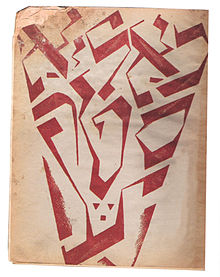|
Di Chaliastre Di Chaliastre or Khalyastre (די כאַליאַסטרע, from Polish "halastra" - gang[1]) was a Jewish avant-garde[2] expressionist-futuristic[3] group of poets, who worked in Warsaw between 1919 and 1924. The poets wrote in Yiddish and published a namesake magazine.[4] The name of the group comes from the term Hillel Zeitlin used for them in the newspaper Der Moment. The group was formed around 1922 around M. Weichert's literary and artistic monthly magazine "Ringen", published since 1921. Its main contributors were Peretz Markish, Melech Ravitch and Uri Zvi Greenberg. Poets Issac Kipnis, Moisei Khashevatsky, and David Hofstein also became a part of the group.[4] History Seth L. Wolitz divided the group's history into three periods:
The first edition of the almanac with the title "Khalyastre" was published in Warsaw in 1922; the editors were Peretz Markish and Israel Joshua Singer. The second issue came out in Paris in 1924; editors: Markish and Oser Varshawski, artist - Marc Chagall.[4][5][1] Moshe Broderzon's poem was chosen as a motto of the journal. "Mir yungen, mir a freylekhe tsezungene khalyastre / Mir geyen in an umbavustn veg, / In tife moreshkhoyredike teg / In nekht fun shrek / Per aspera ad astra!" (We, the young, a happy, boisterous gang / We're trodding on an unknown path / through deeply melancholic days / through nights of fright / Per aspera ad astra!). The poem was first published in Moshe Broderzon's journal Yung-yidish in Łódź, 1919.[4] The almanac "Albatross" was also published under the editorship of Greenberg; (issue 1, Warsaw, 1922; issue 2, Berlin, 1923). The books of the leaders of "Khalyastre" caused a wide resonance - "Nakete Lider" ("Naked Poems", 1921) by Melech Ravitch, "Mephisto" ("Mephistopheles", 1922) by Uri Zvi Greenberg, and "Di Coupe" ("Heap", 1922) by Peretz Markish, in which the theoretical propositions proclaimed by the group - the renewal of the poetic language, the exaltation that explodes verse and the "revolution of the spirit" - are expressed with vivid artistic force. Beginning in 1923, the paths of the members of the group diverged and its activity began to die down.[3] The main reasons were political disagreements and emigration of its members from Warsaw.[4] References
Sources
|
Portal di Ensiklopedia Dunia